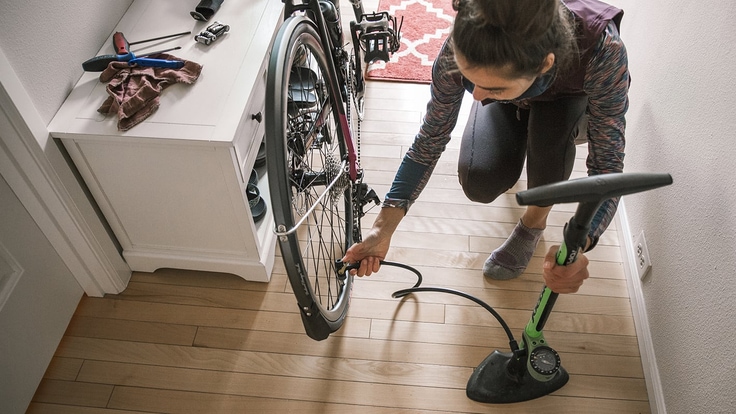Every bicycle rider should be prepared to pump up a flat tire or simply to top off their tire pressure to the recommended settings. To do so, you'll probably want a bike pump for home and another for your bike.
This article takes a look at your choices of bike pumps so you can shop wisely.
Valve Compatibility
Virtually all bike tubes use either Presta or Schrader valve stems. A third option, Dunlop, is rarely encountered in U.S. but can be found on some bikes internationally.
Bike pumps generally can handle either valve type. When shopping, just be aware that lower-priced pumps may require you to use an adapter to fit one of the valve types. Most others will adjust automatically to fit either Presta or Schrader valves—no adapters needed.
Floor Pumps
These beefy, leave-at-home pumps are perfect for garage and bike shop use. They provide high-capacity air-filling power (some models inflate up to 220psi/10 bar) for a variety of tasks in addition to bike tires, and they can handle high-pressure pump jobs that many smaller portable pumps cannot. Most have large, built-in gauges for easy pressure readings.
Floor pumps are your fastest, safest pump option.
REI's floor pump selection includes top brands such as crankbrothers, Topeak and Planet Bike.
Frame-fit Pumps
Best for road cyclists, these pumps snap directly onto your road-bike frame (normally under the top tube) without the extra mounting hardware that mini-pumps require. They're longer and heavier than most mini-pumps, but they work more quickly. Their large capacity (up to 160psi) is designed to fill the high-pressure tires used on road bikes.
Frame-fit pumps come in sizes (S, M, L, etc.) based on either your total frame size (measured in cm) or the top-tube length (in mm). Be sure you know your bike's info before shopping.
Mini Pumps
These small, lightweight pumps provide a quick, easy solution to flats on the road or trail. Most can be attached to various places on your bicycle frame (some can even fit under your water bottle) using mounting hardware or a rip-and-stick strap. Mountain bikers tend to keep their mini-pumps safely inside their hydration pack, away from trail obstacles.
When shopping, consider the psi capacity of the pump:
- Models up to 90psi are suitable for mountain or comfort bikes.
- Models up to 120psi offer fastest for mountain or comfort bikes; OK for some road bikes.
- Models up to 160psi are ideal for road bikes.
Many mini-pumps now come with a built-in hose. This handy feature reduces pumping stress on the valve stem, which can actually break off during use by a standard rigid pump if you're not careful.
CO2 Inflators
These offer a quick, temporary fix in a lightweight, minimalist option. Popular with racers and anyone who want to ride light (they can fit in a jersey pocket), an inflator kit consists of a nozzle and a cartridge. There is no pumping involved. Cartridges are essentially single-use only as, once used, any remaining CO2 leaks out after a few hours.
Repair or replace your damaged tube and fill with blasts of the CO2. It should easily last through the end of your ride. Once you get home, let all of the CO2 out of your tube and pump it back up with air.
Cartridge shopping tips:
- The 16g size is best for a single 700c road tire.
- The 20g size can fill a pair of 700c tires or a single (26" or 29") mountain bike tire.
- Some nozzles include a shut-off valve to make inflation more precise.
- Some nozzles and cartridges are threaded—others are not—so make sure you get a compatible set when buying replacement cartridges.
Tire Pressure Ranges
The correct tire pressure depends on a variety of factors: tire size and sidewall thickness, rider weight, riding conditions and more. In general, fully inflated tires are best for smooth conditions; slightly underinflated tires may be better for rough roads or trails.
Pounds per square inch (psi) is the standard US measurement; "bars" are the metric equivalent. An approximate guide to recommended tire-pressure range:
- Road bike: 80-130 psi / 5.5-9 bars
- Comfort bike: 35-70psi / 2.2-4.8 bars
- Mountain bike: 30-60psi / 2.1-4.2 bars
